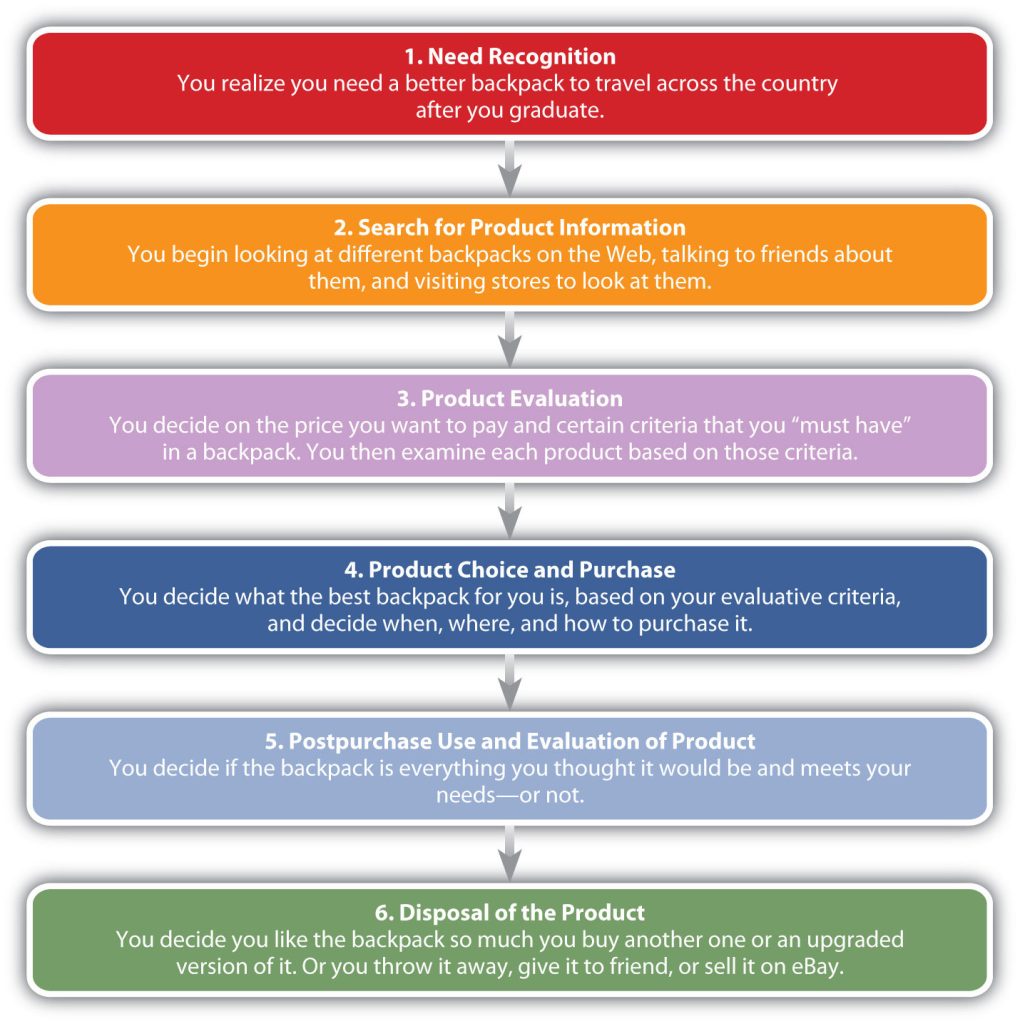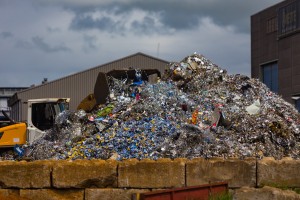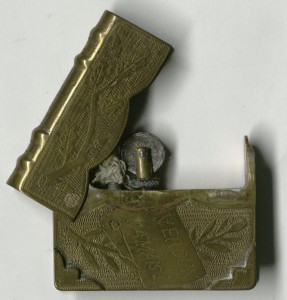6.2 Consumer Decision Making Process
When you last bought a soft drink, or a snack item, what did your decision making process look like? My guess is that you answered that question with a ‘huh?’ As consumers we do not give much thought to our process even though we go through this process constantly. As marketers, by understanding the processes, and by making strategic decisions to address each stage, we help consumer to keep this process seamless and, hopefully, simple.
In this section, we will discuss the consumer decision making process and look at each step in detail.
Stages in the Consumer Decision Making Process
Figure 6.2 “Stages in the Consumer’s Decision Making Process” outlines the buying stages consumers go through. At any given time, you’re probably in a buying stage for a product or service. You’re thinking about the different types of things you want or need to eventually buy, how you are going to find the best ones at the best price, and where and how will you buy them. Meanwhile, there are other products you have already purchased that you’re evaluating. Some might be better than others. Will you discard them, and if so, how? Then what will you buy? Where does that process start? The figure below summarizes the consumer purchasing process using the backpack example that is described in detail below the graphic.
Figure 6.2: Stages in the Consumer’s Purchasing Process

Stage 1. Need Recognition
Need recognition occurs when the consumer becomes aware of an unmet need or want.
You plan to backpack around the country after you graduate and don’t have a particularly good backpack. You realize that you must get a new backpack. You may also be thinking about the job you’ve accepted after graduation and know that you must get a vehicle to commute. Recognizing a need may involve something as simple as running out of bread or milk or realizing that you must get a new backpack or a car after you graduate. Marketers try to show consumers how their products and services add value and help satisfy needs and wants. Do you think it’s a coincidence that Gatorade, Powerade, and other beverage makers locate their machines in gymnasiums so you see them after a long, tiring workout? Previews at movie theaters are another example. How many times have you have heard about a movie and had no interest in it—until you saw the preview? Afterward, you felt like you had to see it.
Stage 2. Search for Information
To make a decision, we need information about the product, the brand, or even the seller. Where does that information come from? It can be from internal sources – meaning your own knowledge and/or experiences – or it can come from external sources such as friends, reviews, web sites, packaging and salespeople.
For products such as milk and bread, you may simply recognize the need, go to the store, and buy more. However, if you are purchasing a car for the first time or need a particular type of backpack, you may need to get information on different alternatives. Maybe you have owned several backpacks and know what you like and don’t like about them. Or there might be a particular brand that you’ve purchased in the past that you liked and want to purchase in the future. This is a great position for the company that owns the brand to be in—something firms strive for. Why? Because it often means you will limit your search and simply buy their brand again.
If what you already know about backpacks doesn’t provide you with enough information, you’ll probably continue to gather information from various sources. Frequently people ask friends, family, and neighbors about their experiences with products. Magazines such as Consumer Reports (considered an objective source of information on many consumer products) or Backpacker Magazine might also help you. Similar information sources are available for learning about different makes and models of cars.
Internet shopping sites such as Amazon.com have become a common source of information about products. Epinions.com is an example of consumer-generated review site. The site offers product ratings, buying tips, and price information. Amazon.com also offers product reviews written by consumers. People prefer “independent” sources such as this when they are looking for product information. However, they also often consult non-neutral sources of information, such advertisements, brochures, company Web sites, and salespeople.
Stage 3. Product Evaluation
Obviously, there are hundreds of different backpacks and cars available. It’s not possible for you to examine all of them. In fact, good salespeople and marketing professionals know that providing you with too many choices can be so overwhelming that you might not buy anything at all. Consequently, you may use choice heuristics, or rules of thumb, that provide mental shortcuts in the decision-making process. You may also develop evaluative criteria to help you narrow down your choices. Backpacks or cars that meet your initial criteria before the consideration will determine the set of brands you’ll consider for purchase.
Evaluative criteria are certain characteristics that are important to you such as the price of the backpack, the size, the number of compartments, and color. Some of these characteristics are more important than others. For example, the size of the backpack and the price might be more important to you than the color—unless, say, the color is hot pink and you hate pink. You must decide what criteria are most important and how well different alternatives meet the criteria.

Osprey backpacks are known for their durability. The company has a special design and quality control center, and Osprey’s salespeople annually take a “canyon testing” trip to see how well the company’s products perform.
melanie innis – break – CC BY-NC-ND 2.0.
Companies want to convince you that the evaluative criteria you are considering reflect the strengths of their products. For example, you might not have thought about the weight or durability of the backpack you want to buy. However, a backpack manufacturer such as Osprey might remind you through magazine ads, packaging information, and its Web site that you should pay attention to these features—features that happen to be key selling points of its backpacks. Automobile manufacturers may have similar models, so don’t be afraid to add criteria to help you evaluate cars in your consideration set.
Stage 4. Product Choice and Purchase
With low-involvement purchases, consumers may go from recognizing a need to purchasing the product. However, for backpacks and cars, you decide which one to purchase after you have evaluated different alternatives. In addition to which backpack or which car, you are probably also making other decisions at this stage, including where and how to purchase the backpack (or car) and on what terms. Maybe the backpack was cheaper at one store than another, but the salesperson there was rude. Or maybe you decide to order online because you’re too busy to go to the mall. Other decisions related to the purchase, particularly those related to big-ticket items, are made at this point. For example, if you’re buying a high-definition television, you might look for a store that will offer you credit or a warranty.
Stage 5. Postpurchase Use and Evaluation
At this point in the process you decide whether the backpack you purchased is everything you were expecting. Whether it is or isn’t, you will probably experience cognitive dissonance. Typically, dissonance occurs when a buyer is questioning their decision. Consumers are more likely to experience dissonance with products that are relatively expensive and that are purchased infrequently.
You want to feel good about your purchase, but you don’t. You begin to wonder whether you should have waited to get a better price, purchased something else, or gathered more information first. Consumers commonly feel this way, which is a problem for sellers. If you don’t feel good about what you’ve purchased from them, you might return the item and never purchase anything from them again. Or, worse yet, you might tell everyone you know how bad the product was. Or, you might like the product but still have doubts or be uncomfortable because you aren’t confident that you made the best decision.
Companies do various things to try to limit dissonance. For smaller items, they might offer a money back guarantee or they might encourage their salespeople to tell you what a great purchase you made. How many times have you heard a salesperson say, “That outfit looks so great on you!” For larger items, companies might offer a warranty, along with instruction booklets, and a toll-free troubleshooting line to call or they might have a salesperson call you to see if you need help with product. Automobile companies may offer loaner cars when you bring your car in for service.
Companies may also try to set expectations in order to satisfy customers. Service companies such as restaurants do this frequently. Think about when the hostess tells you that your table will be ready in 30 minutes. If they seat you in 15 minutes, you are much happier than if they told you that your table would be ready in 15 minutes, but it took 30 minutes to seat you. Similarly, if a store tells you that your pants will be altered in a week and they are ready in three days, you’ll be much more satisfied than if they said your pants would be ready in three days, yet it took a week before they were ready.
Stage 6. Disposal of the Product
There was a time when neither manufacturers nor consumers thought much about how products got disposed of, so long as people bought them. But that’s changed. How products are being disposed of is becoming extremely important to consumers and society in general. Computers and batteries, which leak chemicals into landfills, are a huge problem. Consumers don’t want to degrade the environment if they can avoid it, and companies are becoming more aware of this fact.
Take for example Crystal Light, a water-based beverage that’s sold in grocery stores. You can buy it in a bottle. However, many people buy a concentrated form of it, put it in reusable pitchers or bottles, and add water. That way, they don’t have to buy and dispose of plastic bottle after plastic bottle, thus damaging the environment in the process. Windex has done something similar with its window cleaner. Instead of buying new bottles of it all the time, you can purchase a concentrate and add water. You have probably noticed that most grocery stores now sell cloth bags consumers can reuse instead of continually using and discarding of new plastic or paper bags.

The hike up to Mount Everest used to be pristine. Now it looks more like this. Who’s responsible? Are consumers or companies responsible, or both?
jqpubliq – Recycling Center Pile – CC BY-SA 2.0.
Other companies are less concerned about conservation than they are about planned obsolescence. Planned obsolescence is a deliberate effort by companies to make their products obsolete, or unusable, after a period of time. The goal is to improve a company’s sales by reducing the amount of time between the repeat purchases consumers make of products. When a software developer introduces a new version of product, it is usually designed to be incompatible with older versions of it.
Products that are disposable are another way in which firms have managed to reduce the amount of time between purchases. Disposable lighters are an example. Do you know anyone today that owns a nondisposable lighter? Believe it or not, prior to the 1960s, scarcely anyone could have imagined using a cheap disposable lighter. There are many more disposable products today than there were in years past—including everything from bottled water and individually wrapped snacks to single-use eye drops and cell phones.

Disposable lighters came into vogue in the United States in the 1960s. You probably don’t own a cool, nondisposable lighter like one of these, but you don’t have to bother refilling it with lighter fluid either.
Europeana staff photographer – A trench art lighter – public domain.
You Try It!

